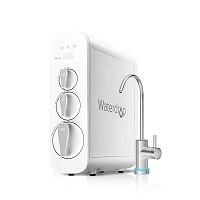People often remineralize their RO water to raise the pH level to meet their preferences. However, not many people know this. There are several water drinkers out there that want to remineralize their RO water but with little to no success.
Remineralization is a relatively easy process. There are many methods to achieve the desired results. But just before we get to that, it is important to know why remineralization is necessary, despite the water already purified.
Read on to find an answer to this question and several others related to healthy water, the mineral components, and how you can remineralize your water to your taste.
RO Water Explained
Reverse Osmosis (RO) water offers a wide range of health benefits. Reverse osmosis is a method of water purification that relies on a counter-osmosis principle. The membrane in reverse osmosis is semipermeable and usually made of a thin film composite. Therefore, it can effectively withhold harmful impurities such as sediments, mercury, lead, and others from making their way into the purified water.
RO systems are effective against water contaminants like arsenic, fluoride, sulfates, and other harmful impurities. It is also effective against the beneficial minerals in the water, including sodium, potassium, calcium, and magnesium. The 99% filtration efficiency rate (or higher) of these filtration systems means they can remove hundreds of contaminants from tap water with no problems.
RO systems offer such a high level of effectiveness because they are equipped with high-pressure industrial RO filters. You may not get the same level of efficiency from lower-cost house filters.
As effective as RO systems are, they cannot remove chlorine or make hard water soft. If you want to soften water, you should combine your RO system with an activated carbon filter, which is effective against over 70 other contaminants. You need an activated carbon filter to remove impurities like pharmaceuticals, chlorine bi-products, herbicides, and pesticides.
Considering that a RO system spares no impurities, both chemicals, and contaminants, where does that leave the nutrient content of the filtered water? Does RO filtered water still contain the relevant nutrients to make you healthy?
How healthy is demineralized water?
There are multiple claims about how healthy pure water is. According to experts, the body stands to benefit from mineral water due to the presence of certain elements in such water. However, food has been continuously identified as the primary source of mineral supplements. So, if water is not the primary source of mineral supplements, drinking demineralized water shouldn’t be a problem.
But things take an interesting turn with a recently released WHO report, which identifies certain health risks associated with drinking pure RO water. Demineralized water, if consumed over time, can affect the body adversely. It puts the intestinal mucous membrane at risk while adversely affecting the metabolism and mineral homeostasis of the body. All these may impair different bodily functions. Also, drinking several liters of low-mineral water after intense physical activities have been linked to severe damages like hyponatremic shock or delirium. This situation is referred to as “water intoxication.”
We are always quick to think that we are not missing any micronutrients, provided we eat healthily. But this is not always true. Meals made with low-mineral water usually lack these essential materials. Consuming such foods over time may lead to a shortage of essential micronutrients in the body. So, rather than following the status quo, we should be intentional about these essential elements and ensure our bodies get enough of them.
Why should you remineralize water?
Reverse osmosis filters help eliminate harmful bacteria, viruses, and other contaminants present in water. But that is not all – they also remove the essential minerals. If you have ever wondered why people remineralize their reverse osmosis water, we have identified a few below:
Remineralized quenches thirst faster.
Quenching your thirst is more effective and faster with ionized water. You can hydrate your body just by drinking the right amount of remineralized water. Ionization occurs when the pH level of water is raised. Remineralized water is safe because it contains safe electrolytes.
Remineralized water contains beneficial minerals.
Essential minerals in water include sodium, magnesium, and calcium, all of which are removed during the reverse osmosis filtration process. The absence of these minerals deprives the body of certain benefits. For instance, calcium helps to prevent weak bones and osteoporosis in women. Sodium also helps with blood pressure regulation.
Remineralized water is better-tasting.
The improved taste of remineralized water is due to the perfect balance between purification and quality. So, you can use your remineralized water to make tea, brewing coffee, baby food, and cooking. There is a clear difference between remineralized or mineralized water and demineralized water, especially in taste and crispness.
How do you remineralize water after reverse osmosis?
Although the necessary microelements are missing in demineralized water, it doesn’t make it unfit for drinking. Reverse osmosis eliminates harmful impurities in drinking water, such as heavy metals, viruses, bacteria, and others. You can find more information about the type of contaminants the RO systems are effective against.
Suppose you decide to stick with RO water. In that case, you should ensure your diet is balanced and your electrolytes replenished after exercise. But if this is not possible, here are a few easy ways to improve your RO drinking water.
Himalayan Salt
The most accessible and most affordable method of remineralizing your RO water is using Himalayan salt. Just a few drops in each gallon of your water, and you have all the minerals again.
NB – Himalayan salt is not the same and does not offer the same results as regular salt.
Himalayan salt ensures the taste of your water remains the same while adding the necessary minerals. Asides from remineralizing your water, it also offers sinus problem relief and helps with weight loss. Water remineralized using Himalayan salt also improves respiratory functions and lowers high blood pressure.
Alkaline Water Pitcher
An alkaline water pitcher makes remineralization easy and fun. All you need to do is keep your water in the alkaline water pitcher. It will restore these beneficial minerals. However, you must be ready to pay some good money for an alkaline water pitcher.
Introduce an alkalization stage to your RO system
If you have an RO system without an alkalization stage from the factory, you can add one. You only need to get an alkaline filter you can attach to your RO system. So, during filtration, the water passes through this alkaline filter and restores these useful minerals, giving you a wonderful drinking experience.
In Conclusion
Remineralizing your water comes with a couple of health benefits. While it remains a personal decision, you should consider any of the remineralization methods described above to ensure you do not miss out on any of the essential minerals your body needs. It is even more important if you are not sure about getting them in your diet.

